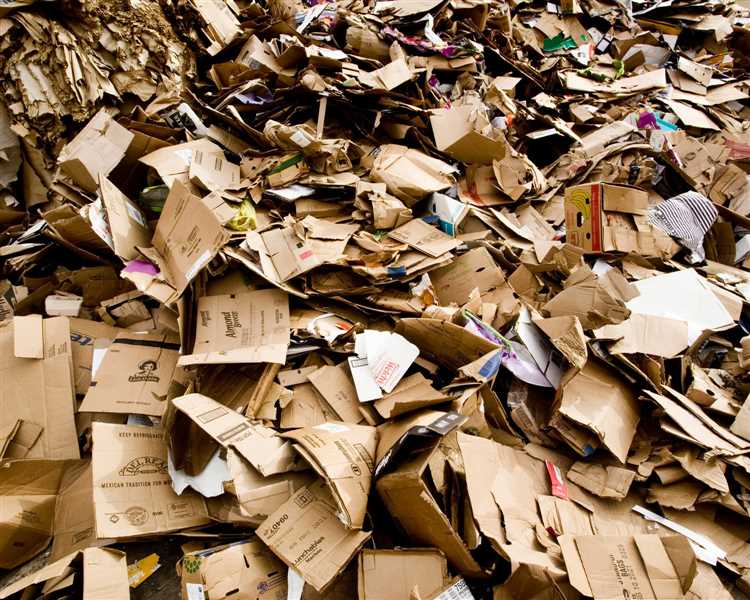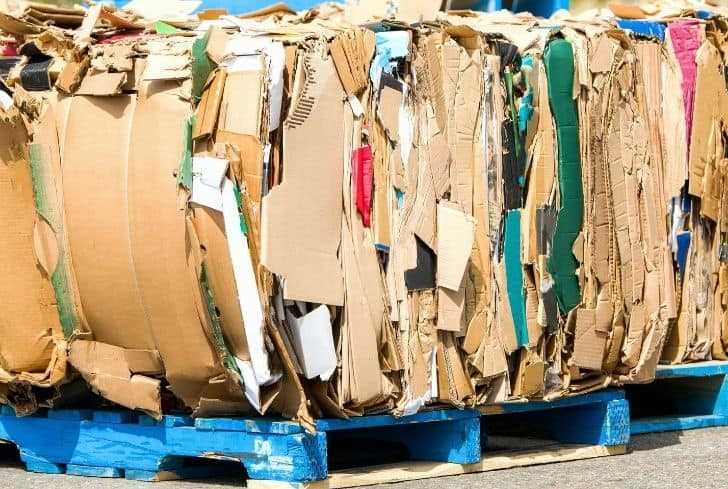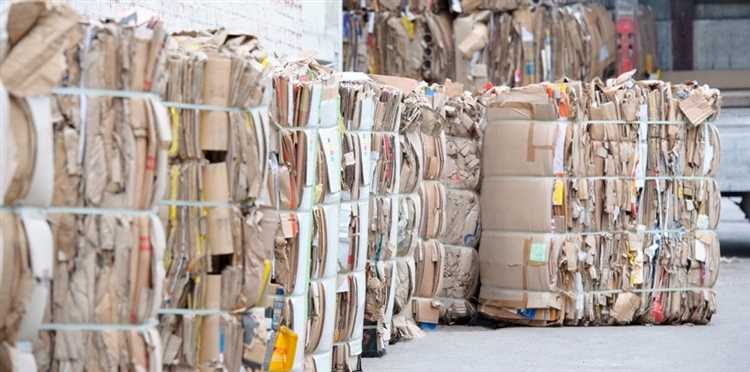
Cardboard is a versatile and widely used material that can be found everywhere, from packaging to construction. It is lightweight, durable, and easily recyclable, making it an environmentally friendly choice.
However, there has been some debate about whether cardboard is truly recycled or if it just ends up in landfills. To understand the truth behind cardboard recycling, it is important to examine the recycling process and the challenges it faces.
When it comes to recycling, cardboard is indeed one of the most recycled materials. The recycling process begins with collection, where cardboard is sorted and separated from other waste. Then, it undergoes a process called pulping, where it is mixed with water and turned into a pulp. This pulp is then cleaned, refined, and formed into new cardboard sheets.
While this sounds promising, the reality is that not all cardboard is recycled. Contamination is a major issue that hinders the recycling process. When cardboard is mixed with other materials, such as food waste or plastic, it becomes difficult to recycle.
Furthermore, the quality of the cardboard plays a role in its recyclability. Cardboard that is soiled, wet, or damaged may not be suitable for recycling. It is important for individuals and businesses to properly dispose of cardboard by keeping it clean and dry to ensure its recyclability.
In conclusion, while cardboard is indeed recycled, it is not a foolproof process. Ensuring that cardboard is properly sorted, free from contamination, and in good condition is essential for its successful recycling. By understanding these challenges, we can work towards a more sustainable future and reduce our dependence on landfills.
- Is Cardboard Recycling Effective?
- Understanding the Cardboard Recycling Process
- The Benefits of Recycling Cardboard
- The Challenges of Recycling Cardboard
- Common Misconceptions about Cardboard Recycling
- 1. All cardboard can be recycled
- 2. Recycling cardboard is not worth the effort
- 3. Recycled cardboard is of lesser quality
- 4. Recycling cardboard is not financially viable
- How to Improve Cardboard Recycling
- The Future of Cardboard Recycling
- Q&A:
- Why should we recycle cardboard?
- Can cardboard be recycled indefinitely?
- How is cardboard recycled?
- Is all cardboard recycled?
- Can cardboard recycling be profitable?
- What is cardboard recycling?
- Is cardboard really recycled?
Is Cardboard Recycling Effective?
Cardboard recycling is an essential part of our efforts to reduce waste and protect the environment. Every year, millions of tons of cardboard are produced and discarded, contributing to the growing problem of waste disposal. Recycling cardboard not only helps to prevent the depletion of natural resources but also reduces the pollution and energy consumption associated with producing new cardboard.
One of the main benefits of cardboard recycling is its ability to save trees. Cardboard is made from wood pulp, which comes from trees. By recycling cardboard, we can reduce the demand for new cardboard, which in turn reduces the need to cut down trees. This helps to preserve our forests, which are vital for the health of our planet.
In addition to saving trees, cardboard recycling also helps to reduce greenhouse gas emissions. When cardboard is recycled, it goes through a process that involves breaking it down into fibers and then reusing these fibers to make new cardboard. This process consumes less energy and produces fewer emissions compared to the production of virgin cardboard. By recycling cardboard, we can reduce our carbon footprint and mitigate the effects of climate change.
Furthermore, cardboard recycling has economic benefits as well. Recycling cardboard creates jobs in the recycling industry and reduces the costs of waste disposal. It also provides a source of raw materials for other industries, such as paper manufacturing. By recycling cardboard, we can contribute to a more sustainable and circular economy.
However, it is important to note that the effectiveness of cardboard recycling depends on various factors. The success of recycling programs relies on proper sorting and collection of recyclable materials, as well as cooperation from individuals, businesses, and governments. Without these essential elements, the recycling process may be inefficient and less effective in reducing waste.
In conclusion, cardboard recycling is an effective way to reduce waste, conserve resources, and protect the environment. By recycling cardboard, we can save trees, reduce greenhouse gas emissions, and promote a more sustainable economy. However, for cardboard recycling to be truly effective, it requires the cooperation and commitment of everyone involved in the recycling process.
Understanding the Cardboard Recycling Process
Cardboard recycling is an essential part of sustainable waste management and plays a crucial role in reducing the environmental impact of cardboard production and disposal. By understanding the cardboard recycling process, we can comprehend the benefits it offers and play an active role in promoting recycling practices.
The first step in the cardboard recycling process is collection. Cardboard is collected through various channels, including curbside recycling programs, dedicated drop-off centers, and commercial recycling services. These collection points ensure that cardboard waste is diverted from landfills and sent to recycling facilities.
Once collected, the cardboard is transported to recycling facilities, where it undergoes sorting and processing. During the sorting process, workers separate cardboard from other recyclable materials, such as paper and plastic. This ensures that the recycling process remains efficient and maximizes the reuse potential of each material.
After sorting, the cardboard is shredded into small pieces, creating what is known as “paper mulch.” This mulch is then mixed with water to create a pulp, which undergoes a cleaning process to remove any contaminants. The cleaned pulp is then formed into sheets, which are dried and rolled into new cardboard products.
It’s important to note that the recycling process for cardboard can differ depending on the type of cardboard being recycled. Corrugated cardboard, which is commonly used in shipping boxes, requires additional steps in the recycling process due to its layered structure. These additional steps involve separating the layers of cardboard, known as “fluting,” and processing each layer separately.
Once the cardboard has been transformed into new products, it can be used to create a wide range of items, including new cardboard boxes, packaging materials, and paperboard products. By recycling cardboard, we can conserve natural resources, reduce energy consumption, and decrease the amount of waste that ends up in landfills.
In conclusion, understanding the cardboard recycling process is essential for promoting sustainable waste management practices. By actively participating in cardboard recycling programs and supporting companies that prioritize recycling, we can contribute to a greener future and reduce our impact on the environment.
The Benefits of Recycling Cardboard
Recycling cardboard has many positive impacts on both the environment and the economy. Here are some of the key benefits:
1. Conserves Resources: Recycling cardboard helps conserve valuable natural resources such as trees. By recycling cardboard, we can reduce the need to cut down new trees and preserve forests.
2. Reduces Energy Consumption: Producing new cardboard from raw materials requires a significant amount of energy. However, recycling cardboard uses much less energy, which helps to reduce carbon emissions and combat climate change.
3. Saves Landfill Space: Cardboard is a bulky material that takes up a lot of space in landfills. By recycling cardboard, we can free up valuable landfill space and reduce the need for new landfills.
4. Creates Jobs: The recycling industry creates jobs at various stages of the recycling process, from collection and sorting to processing and manufacturing. By recycling cardboard, we can contribute to job creation and support local economies.
5. Reduces Water Pollution: The production of new cardboard involves the use of water in large quantities. By recycling cardboard, we can reduce water pollution associated with the paper manufacturing process and help protect our water resources.
6. Lowers Greenhouse Gas Emissions: Recycling cardboard reduces the emission of greenhouse gases like methane and carbon dioxide that are released during the decomposition of organic waste in landfills.
7. Promotes Circular Economy: By recycling cardboard, we contribute to the creation of a circular economy where materials are reused and recycled instead of being disposed of as waste. This helps to create a more sustainable and resource-efficient system.
Overall, recycling cardboard is a simple yet effective way to reduce waste, conserve resources, and protect the environment. By participating in cardboard recycling programs, individuals and businesses can make a significant positive impact on the planet.
The Challenges of Recycling Cardboard
While cardboard is often considered a highly recyclable material, there are several challenges associated with its recycling process. These challenges can hinder the efficiency and effectiveness of cardboard recycling efforts:
- Contamination: One of the main challenges in recycling cardboard is contamination. Cardboard can easily become contaminated with other materials such as food waste, grease, or liquids. Contaminated cardboard cannot be recycled effectively and may end up being discarded as waste. To ensure successful recycling, it is crucial to properly separate and clean cardboard before sending it for recycling.
- Size and shape: Another challenge is the size and shape of cardboard materials. Cardboard boxes come in various sizes and shapes, and these differences can create difficulties during the recycling process. Sorting and processing different sizes and shapes of cardboard can be time-consuming and require special equipment. This can increase the cost and complexity of the recycling process.
- Transportation: Transportation logistics also present a challenge in cardboard recycling. Cardboard materials need to be collected from various sources and transported to recycling facilities. The transportation process can be expensive and energy-intensive, especially when cardboard is collected from multiple locations. Efficient transportation planning is necessary to minimize the environmental impact of cardboard recycling.
- Market demand: The availability and demand for recycled cardboard can also pose challenges. If there is limited demand for recycled cardboard products, it can create a surplus of recycled materials. This surplus can lead to increased storage costs and make recycling economically unviable. Developing and promoting markets for recycled cardboard products is crucial to maintain a sustainable recycling industry.
- Mixed materials: Cardboard packaging often includes mixed materials, such as tape, labels, or plastic inserts. These mixed materials can complicate the recycling process as they need to be separated from the cardboard before recycling. Manual sorting and removal of these materials can be time-consuming and labor-intensive, adding to the challenges of cardboard recycling.
Despite these challenges, cardboard recycling remains a vital part of waste management and sustainability efforts. By addressing these challenges through improved collection methods, technological advancements, and public awareness, we can enhance the effectiveness and efficiency of cardboard recycling and reduce the environmental impact of cardboard waste.
Common Misconceptions about Cardboard Recycling

Cardboard is a widely used material that can be found in many different products and packaging. However, there are several common misconceptions about cardboard recycling that are important to address.
1. All cardboard can be recycled
One common misconception is that all cardboard can be recycled. While it is true that many types of cardboard can be recycled, not all cardboard is created equal. For example, cardboard that is contaminated with food or other substances may not be suitable for recycling. It is important to properly prepare and clean cardboard before recycling it to ensure that it can be processed correctly.
2. Recycling cardboard is not worth the effort
Some people believe that recycling cardboard is not worth the effort due to the resources and energy required for the recycling process. However, this is a misconception. Recycling cardboard is actually beneficial for the environment because it reduces the need for new materials, conserves energy, and prevents landfill waste. Additionally, many recycling programs make it easy to recycle cardboard by providing designated bins and pickup services.
3. Recycled cardboard is of lesser quality
Another misconception is that recycled cardboard is of lesser quality compared to new cardboard. While it is true that recycled cardboard may not be as strong as new cardboard, it can still be used for a variety of purposes. Recycled cardboard can be used for packaging, corrugated boxes, and even construction materials. Advances in recycling technology have made it possible to produce high-quality products from recycled cardboard.
4. Recycling cardboard is not financially viable

Some businesses and individuals believe that recycling cardboard is not financially viable. However, this is not necessarily true. Many recycling programs offer incentives for recycling cardboard, such as discounted waste disposal fees or rebates. Additionally, recycling cardboard can save businesses money in the long run by reducing waste disposal costs and potentially lowering the need for new packaging materials.
In conclusion, it is important to dispel these common misconceptions about cardboard recycling. By understanding the facts and benefits of recycling cardboard, we can all contribute to a more sustainable future.
How to Improve Cardboard Recycling
Cardboard recycling is crucial for reducing waste and promoting sustainability. Here are some tips on how to improve cardboard recycling:
- Proper Sorting: It is important to properly sort cardboard from other types of waste. Make sure to separate clean and dry cardboard from contaminated materials or items with non-recyclable coatings.
- Break Down Boxes: Before recycling, break down cardboard boxes to maximize space in recycling bins and trucks. Remove any tape or plastic packaging attached to the boxes.
- Remove Non-Cardboard Materials: Ensure that all non-cardboard materials, such as Styrofoam or plastic wrap, are removed from the cardboard. These materials can contaminate the recycling process.
- Recycle Cardboard Tubes: Cardboard tubes from paper towels, toilet paper, and other products can also be recycled. Flatten them before recycling to save space.
- Reuse Cardboard: Consider reusing cardboard before recycling it. Cardboard boxes can be used for storage, arts and crafts, or other purposes before they are eventually recycled.
- Support Local Recycling Programs: Educate yourself about your local recycling programs and follow their guidelines. Many communities offer curbside recycling or drop-off centers for cardboard and other recyclable materials.
- Spread Awareness: Encourage others to recycle cardboard by spreading awareness about its importance. Share information about the benefits of recycling and how it helps conserve resources and protect the environment.
- Advocate for Change: Support advocacy groups or initiatives that promote cardboard recycling and push for improved recycling infrastructure. Encourage businesses and organizations to implement sustainable practices, including proper cardboard recycling.
By following these tips, you can contribute to the improvement of cardboard recycling and make a positive impact on the environment. Remember, every small effort counts!
The Future of Cardboard Recycling
Cardboard recycling plays a crucial role in creating a sustainable future. With the increasing use of cardboard in packaging and shipping, it is essential to find innovative solutions to recycle this material efficiently.
One of the promising trends in the future of cardboard recycling is the development of advanced sorting technology. Traditional recycling processes often rely on manual sorting, which can be time-consuming and prone to errors. However, new technologies like optical scanners and robotic sorting systems are being developed to automate the process, making it more efficient and accurate.
Another area of focus in the future of cardboard recycling is the development of more eco-friendly materials. While cardboard is already a renewable and easily recyclable material, researchers are working on ways to make it even more sustainable. This includes exploring alternative sources for the paper used in cardboard, such as agricultural waste or fast-growing plants.
In addition to technological advancements and material innovations, there is also a growing emphasis on consumer education and awareness. Many people are not aware of the importance of recycling cardboard and the impact it can have on the environment. By promoting education and awareness campaigns, we can encourage more individuals and businesses to participate in cardboard recycling programs.
The future of cardboard recycling holds great promise. With advancements in technology, the development of eco-friendly materials, and increased awareness, we can create a more sustainable and environmentally friendly world.
Q&A:
Why should we recycle cardboard?
Recycling cardboard helps to conserve natural resources, reduce pollution, and save energy. It also reduces the amount of waste that goes into landfills.
Can cardboard be recycled indefinitely?
No, cardboard can only be recycled a few times before its fibers break down and become too short to be re-used. However, cardboard can be recycled into other paper products.
How is cardboard recycled?
Cardboard is typically collected from homes and businesses and taken to recycling facilities. It is then sorted, shredded, and pulped to remove any contaminants. The pulp is then bleached, pressed, and dried to produce new cardboard.
Is all cardboard recycled?
No, not all cardboard is recycled. Some cardboard may be contaminated with food waste or other materials that make it difficult to recycle. Additionally, some communities may not have access to recycling facilities for cardboard.
Can cardboard recycling be profitable?
Yes, recycling cardboard can be profitable for businesses. The cardboard can be sold to recycling facilities, which pay for the material based on its weight and quality.
What is cardboard recycling?
Cardboard recycling is the process of collecting used cardboard, processing it, and turning it into new cardboard products.
Is cardboard really recycled?
Yes, cardboard is one of the most commonly recycled materials. It is highly recyclable and can be reused to create new cardboard products multiple times.